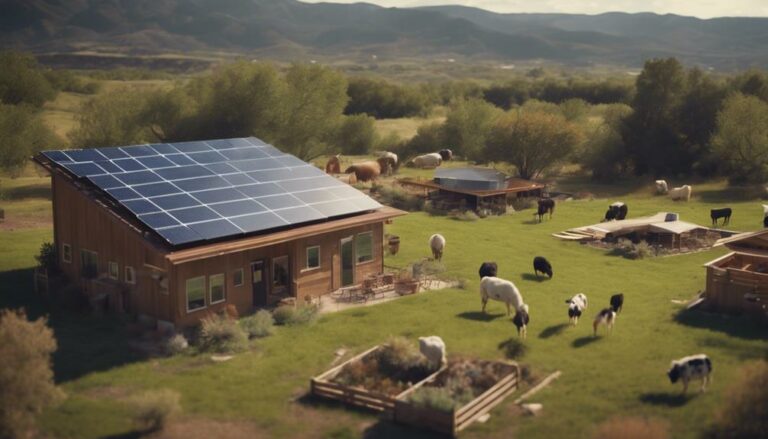Did you know that eco-friendly construction practices can greatly enhance the sustainability of your ranch while minimizing its environmental footprint? By adopting innovative techniques such as sustainable materials, water recycling, and energy-efficient design strategies, you can create a ranch that not only benefits the environment but also guarantees long-term viability. Discover how these practices can transform your ranch into a model of sustainability and resilience, setting it apart in the world of eco-conscious construction.
Key Takeaways
- Use sustainable materials like bamboo and thatched roofs for ranch construction.
- Implement water recycling techniques to minimize water wastage and pollution risks.
- Incorporate energy-efficient design strategies like passive solar heating.
- Benefit from reduced carbon emissions, water conservation, and improved soil health.
- Opt for eco-friendly construction practices to utilize natural materials and promote environmental sustainability.
Sustainable Materials for Ranch Construction
When constructing a sustainable ranch, opt for bamboo, that fast-growing renewable material known for its lightweight and versatile properties. Bamboo is an eco-friendly choice that can be used in various ways, from structural elements to decorative finishes.
Thatched roofs, made from natural materials like straw or reeds, not only provide insulation but also promote traditional building practices, adding a touch of authenticity to your ranch.
Recycled steel is another sustainable option, offering durability while reducing waste and environmental impact.
Rammed earth construction, using compacted soils, seamlessly blends with the natural environment and provides sustainable building solutions for ranches.
Clay and mud bricks, sourced locally, not only offer natural warmth but are also commonly used in adobe-style construction for eco-friendly ranch buildings. These lightweight materials ensure your ranch isn't only environmentally conscious but also aesthetically pleasing and sustainable in the long run.
Water Recycling Techniques for Ranches
Implementing innovative water recycling techniques on ranches enhances sustainability by capturing and treating runoff water for efficient reuse in irrigation and livestock watering. Water recycling plays an important role in ranch conservation efforts, helping to minimize water wastage and reduce the demand for freshwater sources.
Techniques such as rainwater harvesting, greywater recycling, and constructed wetlands are instrumental in sustainable water management practices on ranches. By recycling water, ranch owners can't only save on costs but also contribute significantly to environmental conservation by lowering water pollution risks and promoting efficient water usage.
Proper implementation of water recycling strategies ensures that ranches operate in harmony with nature, utilizing available resources responsibly while safeguarding the environment. Embracing water recycling practices in ranch operations is a proactive step towards achieving long-term sustainability goals and fostering a greener, more efficient ranching community.
Energy-Efficient Design Strategies
Maximize energy efficiency in your ranch construction by incorporating cutting-edge design strategies that can greatly reduce energy consumption and promote sustainability. To achieve this, consider the following energy-efficient design strategies:
- Implement Passive Solar Design: Utilize the sun's energy through strategic placement of windows and thermal mass to provide a substantial portion of your heating needs.
- Ensure Proper Insulation and Air Sealing: By properly insulating your ranch and sealing any air leaks, you can greatly decrease energy costs by preventing heat loss and maintaining a consistent temperature indoors.
- Install Energy-Efficient Windows: Opt for energy-efficient windows that can reduce energy loss by 25-50% compared to standard windows, enhancing the overall insulation of your ranch.
- Utilize Energy-Efficient Appliances and Lighting Fixtures: Incorporating energy-efficient appliances and lighting fixtures can lead to substantial savings of up to 30% on your energy bills, contributing to a more sustainable and cost-effective construction.
Passive Solar Heating for Sustainable Ranches
To harness the natural warmth of the sun and elevate sustainability in your ranch construction, embrace the principles of passive solar heating. Passive solar heating integrates design elements and materials that capture and retain solar heat, providing natural warmth to ranch buildings. By incorporating features such as south-facing windows, thermal mass materials, and overhangs, you can optimize solar gain and heat retention effectively. This sustainable heating approach not only reduces dependency on fossil fuels but also lowers energy costs and minimizes the environmental impact of your ranch operations. Tailoring passive solar design principles to your specific ranch structures can greatly enhance heating efficiency, aligning perfectly with eco-friendly construction practices and promoting overall sustainability in your ranch endeavors.
| Passive Solar Heating Benefits | Description |
|---|---|
| Reduces Fossil Fuel Dependency | Decreases reliance on non-renewable resources |
| Lowers Energy Costs | Saves money on heating expenses |
| Minimizes Environmental Impact | Reduces carbon footprint and greenhouse gas emissions |
Benefits of Eco-Friendly Ranch Construction
Embracing sustainability in your ranch construction enhances environmental stewardship and fosters a greener future for agriculture. By opting for eco-friendly practices, you can experience a multitude of benefits that not only positively impact your ranch but also contribute to the preservation of the environment. Here are some advantages of eco-friendly ranch construction:
- Reduction of Carbon Emissions: Implementing sustainable practices lowers carbon emissions, mitigating the environmental impact of your ranch.
- Conservation of Water: Utilizing water-efficient systems helps conserve this precious resource and promotes responsible water usage.
- Improvement of Soil Health: Eco-friendly construction methods contribute to maintaining soil health, preserving its fertility for agricultural purposes.
- Utilization of Natural Materials: By incorporating natural materials in construction, you reduce the reliance on synthetic products, supporting a more eco-conscious approach.
Conclusion
You've learned about the importance of eco-friendly construction practices for sustainable ranches.
Did you know that using recycled steel in construction can save up to 75% of energy compared to using virgin materials?
By incorporating sustainable materials, water recycling techniques, and energy-efficient design strategies, you can create a ranch that not only benefits the environment but also guarantees long-term success.
Start building your eco-friendly ranch today and make a positive impact on the planet!

